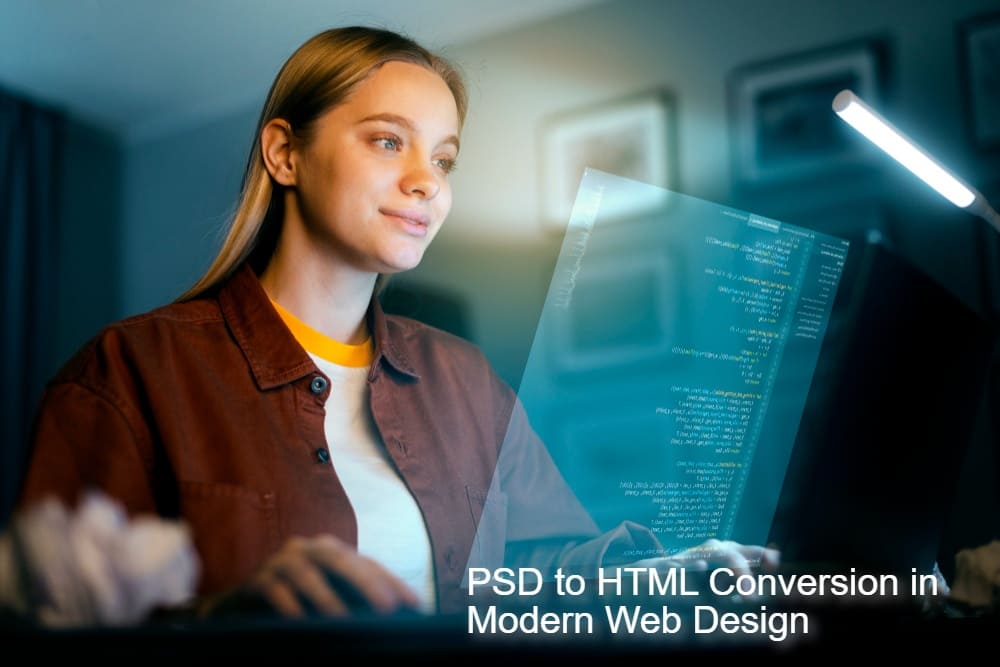The Importance of PSD to HTML Conversion in Modern Web Design
 Jennifer Murph
Jennifer Murph
PSD to HTML conversion involves translating a designer's static visual representation into a code structure that browsers can interpret. This process is crucial for turning a creative vision into a tangible and interactive online experience.
In the current era, where user experience plays a pivotal role, PSD to HTML conversion is indispensable. It bridges the gap between design and functionality, ensuring that websites not only look stunning but also deliver a seamless and responsive user experience.
Benefits of PSD to HTML Conversion
A. Responsive Design
One of the primary advantages of PSD to HTML conversion is the creation of responsive designs. Websites need to adapt to various screen sizes, and this process ensures that the layout remains consistent across devices.
B. Improved Loading Speed
Optimizing website performance is crucial for retaining users. Converting PSD to HTML allows for streamlined code and optimized images, resulting in faster loading times and a smoother user experience.
C. Cross-Browser Compatibility
In a world with multiple browsers and platforms, cross-browser compatibility is a must. PSD to HTML conversion ensures that a website functions seamlessly across different browsers, enhancing its reach and accessibility.
SEO-Friendly Nature
A. Clean Code Structure
Search engines favor clean and well-structured code. PSD to HTML conversion produces code that is easy for search engines to crawl, positively impacting the website's search engine optimization (SEO) performance.
B. Semantic HTML Elements
Semantic HTML elements contribute to better SEO rankings by providing context to the content. This process ensures that search engines understand the hierarchy and importance of different elements on a webpage.
C. Image Optimization
Optimizing images during the conversion process not only improves website performance but also positively affects SEO. Search engines consider page loading speed and optimized images as ranking factors.
Importance for User Experience
A. Consistency in Design
PSD to HTML conversion maintains consistency in design across various pages of a website. This consistency is essential for creating a cohesive and visually appealing user interface.
B. Enhanced Interactivity
The conversion process allows for the integration of interactive elements, such as sliders, pop-ups, and dynamic forms, enhancing the overall user experience and engagement.
C. Accessibility Features
By adhering to web standards and best practices, PSD to HTML conversion ensures that websites are accessible to users with disabilities. This inclusivity is a key aspect of modern web design.
Challenges in PSD to HTML Conversion
A. Browser Incompatibility
Dealing with the differences in how various browsers interpret code can pose a challenge during the conversion process. Testing across multiple browsers is essential to ensure consistent performance.
B. Code Validation Issues
Ensuring that the converted code adheres to HTML and CSS standards is crucial for the website's stability. Validation issues can lead to unexpected behavior and hinder SEO efforts.
C. Time and Resource Constraints
The intricate nature of PSD to HTML conversion, coupled with tight deadlines, can strain resources. It's essential to manage time effectively and allocate resources appropriately to overcome these challenges.
Best Practices for PSD to HTML Conversion
A. Organized File Structure
Maintaining a well-organized file structure during conversion facilitates easier debugging and future updates. This practice ensures that the code is scalable and easy to understand.
B. Semantic Coding
Using semantic HTML and CSS coding practices not only aids SEO but also enhances the readability of the code. This makes it easier for developers to collaborate and maintain the website.
C. Testing and Debugging
Thorough testing across various browsers and devices is crucial. Identifying and addressing issues during the testing phase prevents potential problems once the website is live.
Tools and Technologies
A. Popular Conversion Tools
Tools like Adobe Dreamweaver, Sublime Text, and online converters facilitate the PSD to HTML conversion process. Choosing the right tool depends on the complexity of the design and the preferences of the developer.
B. HTML5 and CSS3 Advancements
The adoption of HTML5 and CSS3 brings advanced features and capabilities to websites. Staying updated with these technologies ensures that the converted websites remain at the forefront of web design trends.
C. Responsive Frameworks
Frameworks like Bootstrap and Foundation provide a solid foundation for responsive web design. Integrating these frameworks during the conversion process streamlines development and ensures compatibility across devices.
Future Trends in PSD to HTML Conversion
A. AI Integration
The integration of artificial intelligence (AI) in the conversion process is anticipated to streamline and automate certain aspects. AI can assist in recognizing patterns and optimizing code for improved efficiency.
B. Voice-Activated Interfaces
As voice-activated technology becomes more prevalent, PSD to HTML conversion may need to adapt to accommodate voice user interfaces. Designing websites that are compatible with voice commands will be a future consideration.
C. Cross-Platform Compatibility
With users accessing websites on various devices, ensuring cross-platform compatibility will continue to be a priority. Future trends may involve even more seamless transitions between different platforms.
Conclusion
In conclusion, the importance of PSD to HTML conversion in modern web design cannot be overstated. From enhancing user experience to improving SEO performance, this process is a key factor in creating successful and visually appealing websites. Embracing best practices, staying updated with emerging technologies, and addressing challenges proactively contribute to the continued success of PSD to HTML conversion.
Subscribe to my newsletter
Read articles from Jennifer Murph directly inside your inbox. Subscribe to the newsletter, and don't miss out.
Written by

Jennifer Murph
Jennifer Murph
Unlocking the power of the web with our expert design and development, where creativity meets technology to create stunning online experiences.